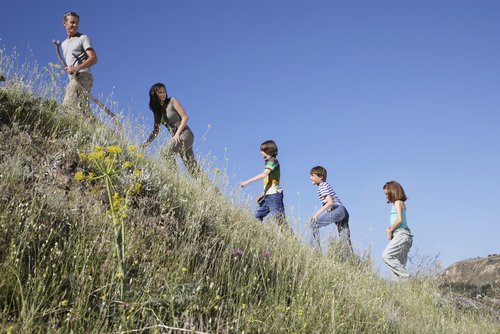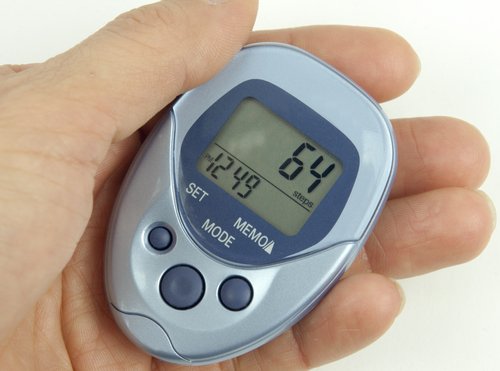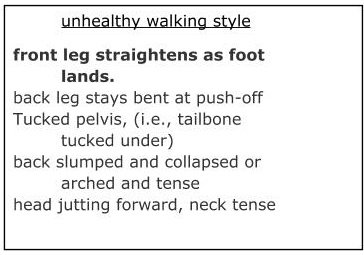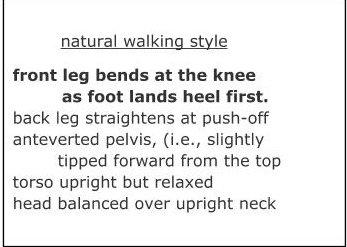These Knees were Made for Walking
As the summer sun mellows and fall approaches, this is my favorite time of year to go hiking. Hiking brings so many benefits, from lifting your spirits and relaxing in fature, to catching up with friends and spending quality time with family.

The physical health benefits of walking are well documented. Choose your terrain well, and hiking provides great cardiovascular exercise for all ages. If you have a sedentary job, walking around town can be an important part of what helps you to achieve and maintain a healthy weight.

10,000 STEPS A DAY
If you like to track your progress, a pedometer to measure and increase your steps is a great fitness tool. Pedometer researcher Dr. Catrine Tudor-Locke published a study in "Medicine and Science in Sports and Exercise" in 2004, showing that men in the survey took an average of 7192 steps per day and the women an average of 5210. The research showed that a sedentary person however might average only 1,000 to 3,000 steps a day. For people in this category, gradually adding steps is the way to go.
A reasonable goal for most people is to increase average daily steps by 500 each week until you can easily average 10,000 per day.
MODERN KNEES HAVE ISSUES
Among the common problems that prevent people from walking very far are knee problems. Ironically, a common source of knee problems is a problematic gait. Moving less then compounds the problem with stiffness and weight gain, which puts even more stress on the knees, setting up a downward spiral.
In our culture we now have an epidemic of knee problems; most are not associated with any injury. Over half a million Americans a year are diagnosed with meniscus (cartilage) tears and bone spurs. They have sometimes suffered years of inflammation, pain and loss of mobility in the joint. Thankfully, surgical repairs can be pretty good at restoring knee function, but it's always best to prevent the damage, try to improve the situation simply if possible, and use surgery as a last resort.
Let’s look at the figures:
http://www.healthline.com/health/total-knee-replacement-surgery/statistics-infographic
More than 4.5 million Americans are living with at least one total knee replacement. That is 4.7% of people aged 50 and over. By age 80+ the figure is 10% and rising
Knee replacements increased by 84% from 1997 – 2009
Osteoarthritis is the principal diagnosis of knee replacement recipients
http://www.healthline.com/health/total-knee-replacement-surgery/understanding-costs
The average cost of knee replacement surgery is $49,500, plus in-patient charges of $7,500
The average cost of knee arthroscopy surgery is $11,900
An estimated 850,000 meniscus surgeries are performed each year
http://www.newchoicehealth.com/Directory/Procedure/130/Arthroscopic%20Knee%20Surgery
A SIMPLE PREVENTIVE POSTURE MEASURE FOR KNEES
If you observe young children’s gait, you will see that they land on a slightly bent front knee. You can also see this in people from non-industrial cultures. Bending the front knee provides extra shock absorption for the knee joint. By contrast, if you are in the habit of landing on a straight leg (a result of inappropriately using your quads to lengthen your stride) the knee cartilage will be subjected to a much greater force as your foot hits the ground.
Landing on a straight front leg is often accompanied by several other postural aberrations as listed below. Conversely, bending your front knee at landing can help induce some of the other aspects of a healthy gait like a stronger, more propulsive action in your back leg and buttocks.
TRY IT
Start from standing with your feet hip width apart in a relaxed micro-squat position (with your knee and hip joints softened). This will help antevert your pelvis. Now imagine you are walking up a hill. This will lean you slightly forward. Your back leg can now propel you forward and your front knee is more likely to be bent at the moment of impact. Squeeze the upper buttock muscles (gluteus medius) of your back leg as it propels you forward, and use this muscle to help slow the landing of your front foot. You should land heel first, but only by just a fraction ahead of the rest of your foot (avoid an extreme heel-toe one-two step). If you succeed in making your landing soft, you will be providing additional protection for the knee.
It may help to try walking barefoot, on dirt or grass if possible. When doing this, you will instrinctively land more softly to protect your feet, which are no longer over-protected by thick shoes.
A good general principle to keep in mind is to use your muscles and spare your joints.


In addition to being a healthier way to walk, you may experience that a lighter landing on a bent front leg is more pleasant than crashing to the ground with a rigid front leg.

Walking is one of the techniques where students most benefit from hands-on coaching. In our six-lesson Gokhale Method Foundations course, we introduce elements of walking in the first lesson and build on them with each successive lesson. This gives students a chance to digest, practice and refine their technique with feedback from the teacher.
Walking habits can be deeply ingrained in your muscle memory and even your psyche—after all, it’s part of who you are and has been a lifetime in the making! It often takes a lot of repetition and hands-on cueing to change these habits. Gokhale Method teachers are trained to help you learn good habits by logically breaking down walking into smaller moves and then linking the new moves together. We teach elements of walking in our Free Workshops, our Initial Consutations and, most comprehensively, in our six-lesson Gokhale Method Foundations course.
We hope to see you in person at one of these offerings!

Comments
I used to hike a lot before
I used to hike a lot before arthritis in my back. Hills are now a challenge. I have to stop often to stretch out my back. Apparently I don't have enough muscle development to keep it stretched out. Should I keep on stretching or use a brace? Is there another solution? I do back exercises every other day to build up those muscles, but still have pain on hills and standing (as in washing dishes).
Add New Comment
Login to add commment
Login